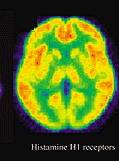Histamine receptors
Histamine receptors are proteins situated in various parts of the body that bind with histamine to produce a specific effect on the organism. There are four known receptors, designated H1 - H4. The receptor that the histamine reacts with is dependant upon where the histamine is released in the body.
 H1: These are one of the most important receptors for modulating your internal clock, and are a main target for many clinical drugs. When histamine reacts with these receptors in your brain (see image, right), it alters your neurochemistry to make you more awake and alert. This is why antihistamines cause drowsiness, as they oppose the reaction of histamine with the H1 receptors. In other areas of your body, stimulation of these receptors causes hives (skin rashes), broncho-constriction, motion sickness, separation of the cell-lining of blood vessels, and smooth muscle relaxation (and consequently vasodilation - the widening of blood vessels leading to redness of the skin). Excess activation of these receptors triggers the symptoms of hayfever and other seasonal allergies.
H1: These are one of the most important receptors for modulating your internal clock, and are a main target for many clinical drugs. When histamine reacts with these receptors in your brain (see image, right), it alters your neurochemistry to make you more awake and alert. This is why antihistamines cause drowsiness, as they oppose the reaction of histamine with the H1 receptors. In other areas of your body, stimulation of these receptors causes hives (skin rashes), broncho-constriction, motion sickness, separation of the cell-lining of blood vessels, and smooth muscle relaxation (and consequently vasodilation - the widening of blood vessels leading to redness of the skin). Excess activation of these receptors triggers the symptoms of hayfever and other seasonal allergies. H2: These are found on parietal cells located in the stomach lining, and are mainly responsible for regulating the levels of gastric acid. Histamine action at these receptors stimulates the release of gastric acid, excess of which can result in gastroenteritis. These receptors are also found on heart, uterus and vascular smooth muscle cells. Histamine reacting with the receptor at these places encourages smooth muscle relaxation. H2 receptors can finally be found on neutrophils (the most common type of white blood cell). Histamine can also inhibit antibody and cytokine production by reacting with these receptors.
H2: These are found on parietal cells located in the stomach lining, and are mainly responsible for regulating the levels of gastric acid. Histamine action at these receptors stimulates the release of gastric acid, excess of which can result in gastroenteritis. These receptors are also found on heart, uterus and vascular smooth muscle cells. Histamine reacting with the receptor at these places encourages smooth muscle relaxation. H2 receptors can finally be found on neutrophils (the most common type of white blood cell). Histamine can also inhibit antibody and cytokine production by reacting with these receptors.H3: These are present throughout the nervous system, though most notably in the central nervous system. They regulate histamine in the body, by inhibiting the further synthesis of histamine. The more of these receptors that are triggered by histamine, the less histamine is produced in the body.
H4: Discovered in 2001, these receptors regulate the levels of white blood cell release from bone marrow. They have also been show to direct mast cells. They are located in the thymus, small intestine, spleen, the colon, bone marrow and basophils.


